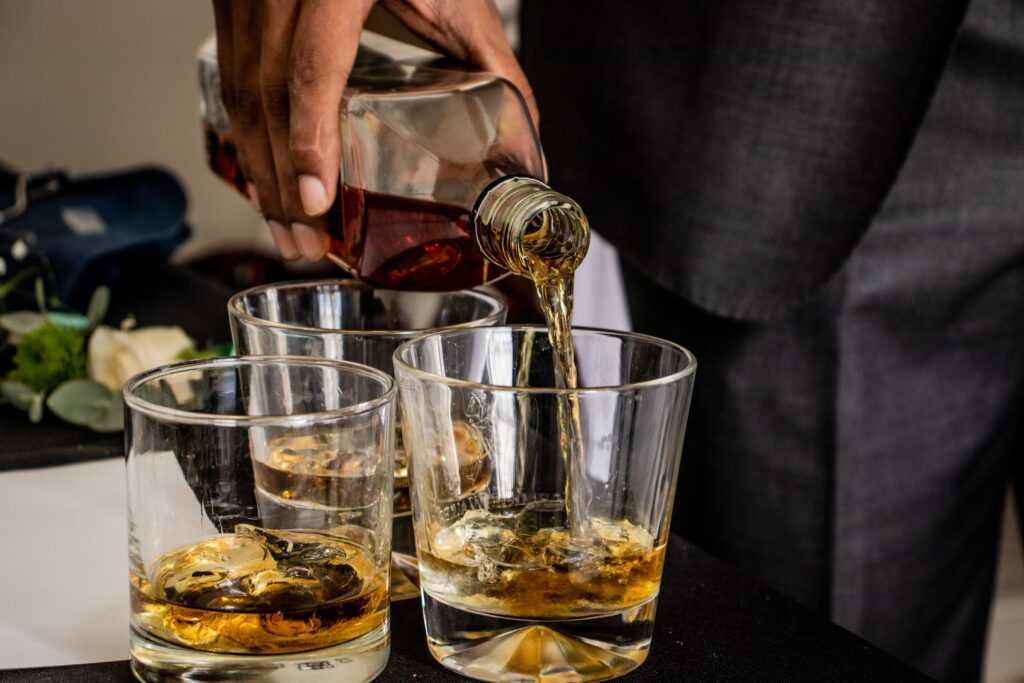Who knew there were so many types of whiskey?
It’s bonkers.
Walk into your local store and whiskey covers entire walls.
What are the differences between the hundreds of whiskey varieties you could choose from?
Great question, my friend.
Because if you like whiskey the differences can be MASSIVE.
Drastically different flavors.
Drastically different proof.
And thousands of miles between locations of origin.
So it’s important to know your whiskey types.
And that’s exactly what we’ll talk about in this article. In a few minutes, you’ll 10x your whiskey knowledge.
What Are The Different Types of Whiskey? The 11 Varieties Explained

1. Straight Whiskey
The Alcohol and Tobacco Tax Trade Bureau (TTB), indicates that whiskey must be distilled from fermented grain to no more than 95% ABV (190 proof) and bottled with a minimum of 40% ABV (80 proof).
To be called straight whiskey, it also must be aged for at least 2 years in new, charred oak barrels and can’t include any additives (like coloring).
According to Distiller.com, after maturation, the only things distillers are allowed to do is batch it with other barrels of straight whiskey, particulate and/or chill-filtering, and bring down the proof with water.
Whew.
Lots of requirements. But at least you know that straight whiskey has been properly handled.
So, in essence, “straight whiskey” is more of a label than a type of whiskey.
But it’s important to understand what it means because you’ll see it often.
You can have:
- Straight bourbon whiskey (51% corn and follows the guidelines above)
- Straight rye whiskey (51% rye and follows the guidelines above)
- Straight whiskey (not made of 51% of any particular grain and follows the guidelines above)
2. Bourbon Whiskey
What makes bourbon bourbon?
The main thing is having at least 51% corn in the mashbill.
It also must:
- Not exceed 80% ABV (160 proof) in the mash
- Age in new, charred oak barrels
- Enter the barrel for aging above 62.5% (125 proof)
- Be made in the U.S. (but not necessarily Kentucky)
- Contain no additives
The corn-heavy mashbill and charred oak barrels give bourbon it’s sweetness and depth.
Specifically, bourbon usually has notes of:
- Vanilla
- Caramel
- Oak
- Char
(But it can also contain all kinds of crazy flavors depending on several factors.)
Some of our favorite brands:
- Four Roses
- 1792
- Buffalo Trace
- Chattanooga Whiskey
3. Rye Whiskey
Rye whiskey is called such because the mashbill is at least 51% rye.
It has the same production requirements as bourbon—it must:
- Not exceed 80% ABV (160 proof) in the mash
- Age in new, charred oak barrels
- Enter the barrel for aging above 62.5% (125 proof)
- Contain no additives
So, how does the rye-heavy mashbill influence taste?
Rye whiskeys are usually spicer than other whiskeys (depending on how much rye is used).
Expect to taste notes of pepper, rye spice, and baking spices.
Some of our favorite brands:
- Wild Turkey 101 Rye
- George Dickel Rye
- Old Forester Rye
- Rittenhouse Rye
4. Wheat Whiskey
You can probably spot the trend with American whiskeys at this point…
Wheat whiskey mashbills contains at least 51% what? … Wheat!
It has the same production requirements as bourbon and rye:
- Can’t exceed 80% ABV (160 proof) in the mash
- Must age in new, charred oak barrels
- Must enter the barrel for aging above 62.5% (125 proof)
- Must contain no additives
How does wheat whiskey taste compared to bourbon and rye?
It’s soft, light, and sweet with floral and bread notes.
Some of our favorite brands:
- Bernheim Straight Wheat Whiskey
- Woodford Reserve Straight Wheat Whiskey
- A.D. Laws Triticum Straight Wheat Whiskey
5. Malt Whiskey
The definition of a malt whiskey changes depending on your setting.
In Scotland, it means the whiskey is made using 100% malted barley (often labeled “single malt”) that is usually aged for at least 3 years in an oak cask.
And that is … drumroll … scotch.
In America, a malted whiskey is made from a mashbill containing at least 51% malted barley.
What does malted whiskey taste like?
The malt-heavy mashbill gives whiskey smoky, nutty, and chocolatey flavors that often taste kinda like cereal.
Some of our favorite brands:
- High West High Country
- Town Branch Malt
- Lagavulin 16 Year Old
- Aberlour 16
6. Blended Whiskey
Blended whiskey is a mix of different types of whiskeys, made from different grains.
If it’s Scotch or Irish, it also has to be aged for at least 3 years.
American blended whiskey is a whole different thing, according to Distiller.com, because at least 20% of it has to be a straight whiskey (remember, 2 years of aging and other requirements at the start of this article).
Blended whiskeys can have wildly different flavor profiles depending on the makeup.
Some of our favorite brands:
- Little Book
- Jameson
- Johnnie Walker Red
7. Tennessee Whiskey
Tennessee whiskey is an unofficial style of bourbon.
All producers with the “Tennessee Whiskey” label must produce their whiskey in Tennessee and use the Lincoln County Process (the use of sugar maple charcoal in the filtering process) before aging.
This process makes the whiskey much more mellow.
Some of our favorite brands:
- Jack Daniels
- George Dickel
8. Irish Whiskey
Irish whiskey is light and easy to drink. It’s usually malt-heavy and contains little to no peat. That means it’s less smoky than scotch and less sweet than bourbon.
Ireland requires that all Irish whiskeys:
- Contain malted barley in the mashbill
- Are distilled to no more than 94.8% ABV (189.6 Proof) before aging in matured oak casks (usually for at least 3 years)
- Are bottled above 40% ABV (80 Proof)
Most Irish whiskeys are triple distilled, meaning the spirit is distilled three times in a pot still, but this is not a requirement.
Some of our favorite brands:
- Jameson
- Redbreast 15 year
- Knappogue Castle 12 Year Single Malt
9. Scotch Whiskey
Scotch usually has strong smoky peat flavors (peat means partially decayed vegetation or organic matter).
It’s far less sweet and much smokier than other whiskeys on this list (especially bourbon).
Many even say it takes 3 or more tries to begin liking it.
But when you’re hooked, you’re hooked.
And once you further develop your palate, you’ll begin to detect notes of dark fruit, vanilla, honey, nuts, and more.
Different scotches can have wildly different flavors due to how long it’s aged, the type of barrel it’s aged in, the grains it’s made from, and the region of Scotland it’s from.
Regardless of these differences, all Scotch must be:
- Made in Scotland
- Made of only water, malted barley, and other cereal grains
- Distilled to no more than 94.8% ABV
- Aged in oak casks for at least 3 years
Some of our favorite brands:
- Aberfeldy 12 Year Old
- Lagavulin Distillers Edition
- Laphroaig 10 Year Old
- Johnnie Walker Gold Label Reserve
10. Japanese Whiskey
Modeled after scotch, Japanese whiskey is made with similar distillation and production processes.
The main difference between them stems from rules and regulations.
Japan allows for much more creativity through their relaxed rules—which has led to the use of different grains in the mash and casks for aging.
And this means drastically different flavor profiles.
The only real requirements for Japanese whiskey are:
- It must be made in Japan (as of April 2021)
- It must include malted grain in the mash
- Any water used in production must be from Japan
- It must be aged in wooden casks for at least 3 years
What do they taste like?
Kinda like scotch with a spin.
Some of our favorite brands:
- Yamazaki 12 Year
- Suntory Toki
- Nikka Coffey Grain
11. Canadian Whiskey
Canadian whiskeys are known for their light and sweet flavor profiles. Like Irish whiskey, they’re usually considered “easy to drink”.
They get their flavor from a few specific things that make them unique from others on this list:
- Canada allows added coloring and flavors up to 9.09% of the total volume
- Most Canadian whiskey is blended (a common technique is blending a high alcohol content whiskey with a low one for flavoring)
This allows distillers freedom to experiment (it’s like the wild west up there).
The only real requirements for Canadian whiskey are:
- They must be produced in Canada
- They must age in small wood (less than 700 liters) for at least 3 years
- They must smell and taste like Canadian whiskey (crazy rule, but true)
What does Canadian whiskey taste like?
Generally, a bit like bourbon but a tad spicier and lighter.
Some of our favorite brands:
- Forty Creek Confederation Oak
- Candian Club 100% Rye
- Crown Royal Deluxe
- Caribou Crossing Single Barrel
Which Is the Best Type of Whiskey? It’s Up to You to Decide
There’s no “one best type of whiskey”.
It’s completely up to the taster’s preferences and birthplace.
This shouldn’t come as a surprise to you, but I like bourbon the best.
(Of course Bourbon Inspector would say that…)
And if you’re thinking about trying bourbon, or already love it, I have some great guides that will help you find the best bottles for your budget:

Hunter Branch is the Founder and Director of Editorial for Bourbon Inspector. He has been writing about and professionally reviewing bourbon since 2020 (and has been drinking it for much longer). He’s been able to interview big names in the bourbon industry like Trey Zoeller from Jefferson’s Bourbon and his work has been featured in publications like TastingTable, Mashed, and more.